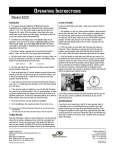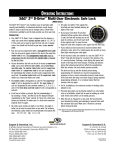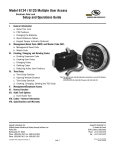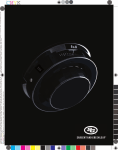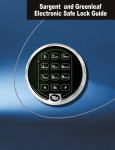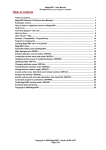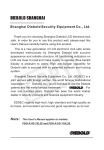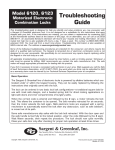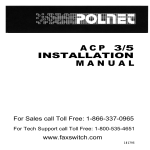Download Sargent and Greenleaf 6120 Operating instructions
Transcript
Operating Instructions Model 6120 Introduction • The Sargent & Greenleaf Model 6120 Motorized Electronic Combination Lock is shipped from the factory with a factory master code of 1 2 3 4 5 6 #. This code is used to open the lock and set or change all of its codes. If the safe maker or your dealer sets a new master code, he will advise you of the change. You should set the lock to your own, unique master code immediately. and open the door. Do not put any pressure on the safe handle until after the code has been entered. The Model 6120 will lock automatically when the safe door is closed and the handle is turned to the locked position. In Case of Trouble If your lock should fail to open when a valid code is entered, check for the following: • The Model 6120 will always open on the master code. At your discretion, it can also be set to accept up to eight different user codes. The master code holder is responsible for maintaining the number of active users programmed into each lock. The master code is designated as code #1, and the user codes (if set) are designated by user I.D. number 2, 3, 4, 5, 6, 7, 8, and 9. The user codes do not exist until they are programmed into the lock. 1. The boltwork of a safe can, under certain conditions, place pressure on the side of the lock’s bolt. This is often caused by something inside the safe pressing against the door or by something caught between the safe door and its frame. When this occurs, the lock will not operate properly. To relieve side pressure on the lock bolt, move the safe’s handle to the fully locked position, then re-enter a working code. The lock should open. • Each time a button is pressed and the lock accepts the input, it emits a “chirp,” and the LED on the keypad lights momentarily. 2. If the lock makes no sound when any of the keys are pressed, or if the lock “chirps” when keys are pressed, but it will not open, the batteries may be drained to the point that they will not operate the lock’s motor. Follow the battery replacement procedure in this manual. • All codes must contain six digits or six letters. Any digit or letter can be used as many times as you wish. For instance, the following codes (while not recommended) will operate the lock: 555555# OR JJJJJJ# • All codes end with #. This signals the lock that you have finished entering all digits of the code. • If you pause more than 10 seconds between pressing buttons when entering a code, the lock will assume you do not want to continue, and it will go into standby mode. To open the lock, begin the code entry sequence from the first step. 3. If the lock makes no sound when any of the keys are pressed, but the batteries have been checked and found to be good, a loose keypad connector may be the cause. If your lock uses the two-battery keypad (pictured to the left of the lock above), pull the keypad away from the base as described in the battery changing procedure. Check to make sure the wire connector is firmly seated into its receptacle on the keypad circuit board. The connector is designed so that it will only slide into the receptacle when aligned correctly. • If you realize you have pressed an incorrect button when entering a code, press * or simply pause ten seconds or more, then begin entering your code again. • If four incorrect codes are entered in a row, the lock will shut down for a period of up to fifteen minutes. This is a security feature. Pressing any button anytime during the lockout period will reset the timer to its maximum penalty time. Do not touch any keypad buttons for a period of fifteen minutes, then enter any valid code to open the lock. • The model 6120 does not have audit trail capabilities. • For UL installations, the maximum number of user codes is one. Note: This lock has been Listed by Underwriters Laboratories for use with the following S&G keypad(s): 6120-0XX, 6120-2XX, 6120-4XX, 6160-2XX (IP Series), 61KP-1XX, 6130-5XX To Open the Lock Press the code digits or letters in order, followed by #. The lock bolt will retract for six seconds, allowing you time to operate the safe handle Sargent & Greenleaf, Inc. A Wholly Owned Subsidiary of Stanley Security Solutions, Inc. PO Box 930 Nicholasville, KY 40340-0930 Phone: (800)-826-7652 Fax: (800)-634-4843 Phone: (859)-885-9411 Fax: (859)-887-2057 © Copyright 2007, Sargent & Greenleaf Wire connector being inserted into the receptacle on the keypad circuit board. If all of the preceding remedies have been exhausted and the lock still does not open, contact a qualified safe technician in your area for professional service. Security Advisory If your lock is used many times a day (50 or more openings daily), it is advisable to use as many different keys as possible in your code number. Avoid using a key more than once whenever possible. Check the keypad frequently for visible wear which might indicate which keys are being pressed for code entry. Change the code to use different keys when wear is evident. If necessary, have a qualified service technician replace the keypad. Sargent & Greenleaf S.A. 9, Chemin du Croset 1024 Ecublens, Switzerland Phone: +41-21 694 34 00 Fax: +41-21 694 34 09 Document 630-302 Revised 7/23/2010 About Changing Codes All code changing procedures begin by pressing SG*(the same as 7 4 *), followed by the existing six-digit master code and #. The lock immediately chirps five times ().If the lock emits a series of closely spaced chirps (almost a continuous tone) you have made a mistake and must start again. Always keep the safe door open when making programming changes. To Change the Master Code (code #1) Press SG* (______) # 1 * (______) # (______) # (74) existing master code new master code new master code Whenever # is pressed, the lock chirps to acknowledge the entry. Wait for the chirps before proceeding. If a long series of closely spaced chirps (almost a continuous tone) sounds when # is pressed, the new master code will not be accepted—the old code is retained. N ote: It is very important to remember your master code. If it is lost, the manufacturer of your safe may be able to help you reset the lock. S&G does not retain any lock codes To Enter or Change a User Code (codes #2—#9) Press SG* (______) # (user I.D.) * (______) # (______) # (74) master code new user code new user code henever # is pressed, the lock chirps to acknowledge the entry. Wait for the chirps before proceeding. If a long series of closely spaced chirps W (almost a continuous tone) sounds when # is pressed, the new code will not be accepted. Any existing user code remains. F or instance, if you want to enable the #2 user code (the first user code) to open the lock with a code of 4 4 6 6 3 3, you will use the following procedure. Press SG* (______) # 2 * 446633# 446633# (74) master code This same procedure would change any existing #2 user code to 4-4-6-6-3-3. To Delete a User Code You may find that a particular user code which you have enabled is no longer needed. It is a good security policy to remove any unneeded codes. To do so, follow this procedure. Press SG* (______) # (user I.D. 2 through 9) * # # (74) master code henever # is pressed, the lock chirps to acknowledge the entry. Wait for the chirps before proceeding. If a long series of closely spaced chirps W (almost a continuous tone) sounds when # is pressed, the user code will not be deleted. The 6120 lock will not allow you to inadvertently delete the master code. To Use the Time Delay The Sargent & Greenleaf Model 6120 Electronic Combination Lock has a built in time delay feature that you can turn on and off by following the programming steps on this page. The time delay can be set anywhere from 0 to 9 minutes. When the time delay feature is enabled, your lock will function as follows: After you enter a valid opening code, the lock will “chirp” three times. It will not open. The lock will “chirp” once every ten seconds during the delay period, and it will not accept any keypad input during the delay period. The lock will “chirp” ten times at the end of the delay period. You must enter a valid opening code within two minutes of the end of the delay period. The lock will open. Instead of entering a valid code, you can use the procedure below to turn the time delay off or set it to a different length. The two minute period immediately following the time delay is the only time during which you can change or delete the time delay. Use of the time delay feature will decrease your battery life by approximately 50%. Battery life will vary depending on the length of the time delay. For instance, batteries will last longer with the time delay set to 1 minute than with the delay set to 9 minutes. A time delay is typically used in situations where there is threat of armed robbery. Statistically, an armed robber will not linger more than a minute or two at a crime scene. The longer he stays, the greater his risk of being caught. A time delay lock enforces a waiting period which is beyond the control of either robber or victim. Whenever a safe is secured with a time delay device, a sign should be posted on the door of the container to indicate the presence of the device. Suggested wording is: “THIS EQUIPMENT IS PROTECTED AGAINST HOLD UP AND ROBBERY BY TIME DELAY LOCK.” A self adhesive label is available from Sargent & Greenleaf distributors or your local safe and lock retailer. The S&G part number for the label is 0000-636-152000. To Set a Time Delay The time delay value can be 1, 2, 3, 4, 5, 6, 7, 8, or 9 minutes. To deactivate the time delay, set its value to 0 minutes. Press SG* (______) # 0 * (_) # (_) # (74) master code delay time delay time Whenever # is pressed, the lock chirps to acknowledge the entry. Wait for the chirps before proceeding. If a long series of closely spaced chirps (almost a continuous tone) sounds when # is pressed, the new time delay value is not accepted—the old time delay value is retained. For instance, if you want to set the time delay to five minutes, use the following procedure. Press SG* (______) # 0 * 5# 5# (74) master code To turn the time delay off, use the following procedure during the two-minute opening window. Press SG* (______) # 0 * 0# 0# (74) master code The Management Reset Code Your lock can incorporate a Management Reset Code if one is programmed before the Factory Master Code is changed or reset. Once the Master Code changing procedure is completed for the first time, a Management Reset Code cannot be installed. Once programmed, the Management Reset Code cannot be deleted or changed. Sargent & Greenleaf strongly recommends that a different Management Reset Code be used for each lock. The Management Reset Code consists of seven digits. Two of the digits must be pressed simultaneously. These digits must be either 0 and 1, or 0 and 3. They may be used anywhere in the code. For instance, a Management Reset Code could be 147 01 89 (0 and 1 are pressed simultaneously). To use the Management Reset Code in this example, press: * 6 # 147 01 89 #.The lock’s Master Code will revert to 1 2 3 4 5 6 #. . . . . Immediately after the Management Reset Code is entered, the lock will beep once for each time the MRC has been used, including the current usage. This simple audit trail is provided to let the safe operator know how many times the Management Reset Code has been used to reset the lock. The Master Code is now reset automatically to the original Factory Master Code (1 2 3 4 5 6 #). Any User Codes which were present in the lock when the Management Reset Code was entered will be erased, as will any time delay value. To Program the Management Reset Code (MRC): Press * * # 123456# (_______) # management reset code (_______) # management reset code If you get a long error tone rather than three short beeps after attempting to program the Management Reset Code, the lock may have had its master code changed, or it may already have an MRC. Contact your safe manufacturer or dealer to obtain it. To Use the Management Reset Code: Press * 6# (_______) # (the Master Code is now 123456#) management reset code Low Battery Condition The Model 6120 lock uses two 9-volt alkaline batteries. We recommend Duracell®. If the batteries in your lock need to be replaced, twenty consecutive beeps will be heard after the last number of the code and the # sign have been pressed. The batteries will have to be replaced before the lock can be opened. Note: A low battery simulator is built into the Model 6120 so you can familiarize yourself with how the lock sounds under a low battery condition. To activate the low battery simulator, depress the * key for approximately three seconds, until the lock emits three chirps. Immediately enter your code. Each time you press a key, the chirp will sound distinctly different than it does during normal operation. Approximately two seconds after you enter the code and open the lock, the Model 6120 will revert to normal keypad tones. Battery Replacement Procedure (standard two-battery keypad) The Model 6120 will NOT forget your code(s) during battery change. The circuitry is designed to hold this information for extended periods of time even if there are no batteries installed. Changing Batteries—Two-Battery Keypad Step 1—Remove the keypad from its mounting base. This can be done by pulling the bottom of the keypad housing away from the base (photo 1). Grip the keypad housing as shown in the photograph for best results. Support the keypad housing so that the wires which are attached to its circuit board are not pulled or stressed. Do not let the keypad hang from its wires. Step 2—Turn the keypad over and remove both batteries. This is best done by grasping the bottom of a battery and pulling it gently away from the keypad circuit board. Do not use any type of tool to pry a battery from its holder. Step 3—Install new batteries by pushing them directly into the battery connectors attached to the keypad circuit board. It’s important to support the connectors so they will not get bent during battery insertion (photo 2). The connectors are designed to make it very difficult to install a battery incorrectly. Pay close attention to battery polarity so as not to damage a connector by forcing a battery into it backwards. Step 4—Hold the keypad housing close to the mounting base while you coil excess wire inside the housing (photo 3). Position the wire away from the spring clips that hold the keypad housing to the mounting base. Step 5—Align the spring clips with the receptacles in the base. Using steady pressure, push the keypad housing back onto its mounting base. Don’t allow any wire(s) to be damaged by contact with the spring clips. The keypad housing will snap into place on the base. Step 6—Check the master code and all user codes at least three times with the safe door open. Close the safe door only after the lock has been thoroughly checked for proper operation. PHOTO 1 PHOTO 2 PHOTO 3 Note: The 6120 will operate with just one 9-volt alkaline battery attached to either connector. This is only recommended under emergency conditions when a second replacement battery is not available. Using a single battery will not harm the lock in any way. Changing Batteries—One-Battery Keypad Step 1—Keypad disassembly is neither required nor advised. The removable battery holder is PHOTO 4 accessed from the bottom of the keypad base. Pull it slightly toward the front of the keypad, then downward to remove it (photo 4). Step 2—As you remove the old battery, you will notice there is a spring at the bottom of the holder. The new battery will rest on top of this spring to maintain good electrical contact. Step 3—Note that the battery is oriented so that the larger contact is in line with the larger opening in the top of the battery holder (photo 5). It’s important to orient the new battery this way. Step 4—With the new battery in the holder, slide the holder into the base of the keypad until it clicks into place (photo 6). If your lock does not operate properly, don’t press any buttons for five minutes, then try it again. PHOTO 5 PHOTO 6




